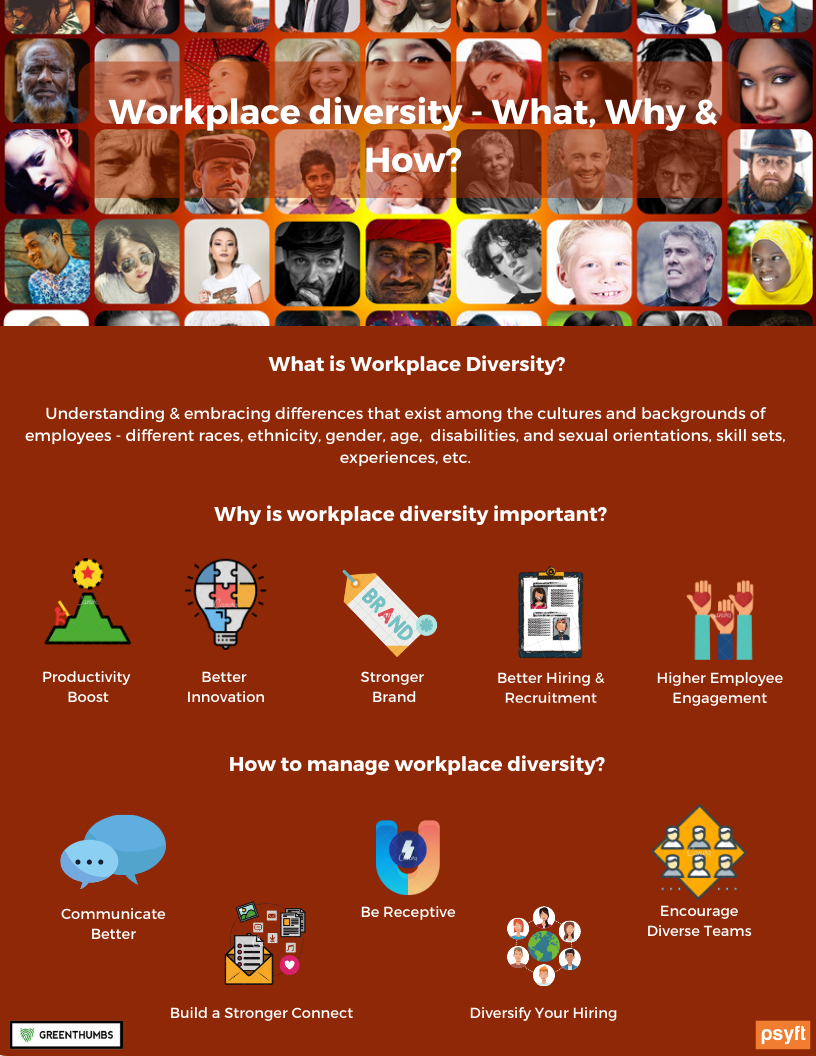Blogs
Your source to the latest insights on what's trending in the HR arena - Recruitment, Talent Assessments, Employee Surveys and Training.

Workplace Diversity - What, Why & How?
The corporate world is changing rapidly and organizations need to live up to these changes in order to move ahead with the times. Bringing “diversity and inclusion” in workplaces is one such change that leaders need to focus upon now, more than ever.
Workplace diversity is an imperative to greater productivity, healthier work culture, increased employee engagement and lesser favoritism. It helps build an organization’s reputation. Workplace diversity is among the key workplace trends. It is a factor that enables organizations to gain a competitive edge. Companies that encourage a more diverse workforce tend to outperform vis à vis their industry peers.
What is workplace diversity?
Workplace diversity, something all organizations should aim to build, grow and nurture, can be simply defined as - the variety of differences between individuals in an organization. Diversity at an organization includes race, gender, ethnic groups, age, language, cultural background, education, religion, sexual orientation, mental and physical conditions, etc. A diverse workplace would be one that employs a wide range of diverse individuals. It’s about understanding, accepting, and valuing differences of races, ethnicities, genders, ages, religions, disabilities, and sexual orientations, skill sets, knowledge bases, etc.
In today’s globalized world, where we have interdependent economies, workplace diversity is no longer a norm that companies are obliged to follow, but a necessity that impacts an organization’s bottom line.
Why is workplace diversity important? – Benefits
Let’s look at a few statistics first –
- Companies that have more diverse management teams have 19% higher revenue (Boston Consulting Group).
- Racially and ethnically diverse companies outperform industry norms by 35% (McKinsey).
- 57% of employees think their companies should be more diverse (Glassdoor).
The benefits of workplace diversity are immense. To highlight a few –
1. Productivity Boost
Workplace diversity brings with it better prospects for productivity. Productivity is about the competence and expertise of both the employees and employers in an organization. Diversity in workforce provides a broad mix of expertise and experience. Employees from different cultural backgrounds bring their own skills and abilities to the table. This leads to collective and more competent problem solving. Moreover, when employees with different backgrounds and perspectives come together, they come up more informed and inclusive decisions.
Thus, workplace diversity offers a platform that fosters open communication, improved teamwork and better decision making, all leading to greater productivity.
2. Better Innovation
A diverse workforce helps an organization bring in more creativity and innovation into business. Diverse organizations have employees belonging to different backgrounds and with different backgrounds comes different perspectives. This difference in perspectives and experiences, if channeled in the right direction, result in insightful knowledge sharing & brainstorming.
Employees are more receptive to new ideas and share their opinions as well thus, building grounds for better innovation at work.
3. Helps build a stronger brand
Organizations that commit to workplace diversity enjoy global visibility and branding, which in-turn leads to greater profitability. A diverse workplace is recognized as one that works towards fair and inclusive employment practices and ethical code of conduct, an organization that is more socially responsible.
The more diverse a workplace is, the more people across the cultures will relate to and identify with it. Diverse workforce also helps organizations broad base their employee strength, market potential, customer base and clientele.
Another Quick Stat – A Harvard Business Review (HBR) study said that 78% of employees work at organizations that lack diversity in leadership positions.
4. Better Hiring & Recruitment
In the current war for talent, where all companies are striving to hire the best; diversity in the workplace boosts a company’s employer brand and makes it a more desirable place to work at. Also, diversity in the workplace helps you choose from a wide range of employees, based on their talents. According to a survey conducted by Glassdoor, 67% of job seekers said a diverse workforce is an important deciding factor, when it comes to considering job offers.
5. Higher Employee Engagement
Workplace diversity leads to higher employee engagement. When an organization offers a diverse and inclusive work culture, employees feel more included, hence more engaged. Employees enjoy working in diverse teams - it keeps them at ease, generates respect for one another, boosts inter-personal relationships and also helps build a healthy work culture.
With workplace diversity comes better team work, better collaborations, lesser bias and favoritism, better employee representation and all this leads to elevated employee morale and employee engagement.
How to Manage Diversity in the Workplace?
So, how can organizations manage diversity at workplace? How can leaders ensure that steps are taken and efforts are made towards promoting a heterogeneous, tolerant, open and conflict-less, diverse culture.
Communicate Better
Whether it is about KPIs, work schedules, organization policies or any other matter; leaders/managers need to ensure these are effectively communicated to employees. Policies, procedures, norms and rules should be conveyed in a way that overcomes any language and cultural barrier that may arise. Use translations, pictures, infographics, etc – whatever suits best to ensure inclusive communication.
Encourage Diverse Teams
Diverse work teams get employees the exposure of working with different people, understand different perspectives, learn to value one another’s opinions and ward off any cultural misunderstandings. Let your teams come together and work out ways to achieve goals collectively. Encourage them to acknowledge different viewpoints, giving opportunities to people to express their ideas and suggestions.
Build a Stronger Connect
Connect with your people, be sensitive towards their unique culture and backgrounds, find out what motivates them. Everyone, no matter what race, gender or demographic, wants to be heard and understood. When you understand what works or does not work for your employees, you can engage each team member better and enhance their efficiency and productivity.
Be Receptive
Embrace the difference! Encourage your employee to express their opinions, suggestions, recommendations and concerns and be receptive to these. Look for ways to bring in diverse minds together to achieve goals. Offer platforms for your employees to give feedback, run an employee feedback survey or a culture survey to gain better understanding of how employees feel about working at their organizations and what are the issues they may be facing. Employee feedback both positive and negative, is valuable and acts as a catalyst to bring about change.
Make Diversity Part of Your Hiring
Hire talent from across backgrounds is perhaps the simplest step towards building a diverse organization. Hiring managers/line managers should keep all sorts of bias at bay while screening and assessing talent. Incorporate a diverse interview panel, train your managers on what aspects are to be focused on while interviewing.
A lot of organizations practice blind hiring these days. Blind hiring is a practice aimed at eliminating biases (over the demographic information of potential hires like race, ethnicity, gender and age, etc.) in recruitment and improving workplace diversity.
Conclusion
Workplace diversity can take your company and your business outcomes to a whole new level. Diversity is a competitive advantage. In order to leverage on this advantage, organizations need to learn to embrace diversity and make it an integral part of their work affairs. In a global talent market, encouraging diversity is the way forward for organizations.
FAQs
1 : What is workplace diversity?
Answer : Workplace diversity refers to the variety of differences between individuals in an organization, including factors such as race, gender, ethnic groups, age, language, cultural background, education, religion, sexual orientation, mental and physical conditions, and more.
2 : Why is workplace diversity important?
Answer : Workplace diversity is crucial because it leads to numerous benefits, including higher revenue, better productivity, increased innovation, a stronger brand image, improved hiring and recruitment, and higher employee engagement.
3 : How does workplace diversity boost productivity?
Answer : Workplace diversity enhances productivity by bringing together employees with diverse skills and backgrounds. This diversity leads to improved problem-solving, open communication, better teamwork, and more informed decision-making.
4 : What role does workplace diversity play in innovation?
Answer : Workplace diversity fosters innovation by promoting different perspectives and experiences within an organization. Diverse employees contribute unique ideas and viewpoints, which drive creativity and innovation.
5 : How can organizations effectively manage diversity in the workplace?
Answer : Organizations can manage workplace diversity by improving communication, encouraging diverse teams, building strong connections with employees, being receptive to feedback, and implementing inclusive hiring practices.
Recent Articles
News Center


- India Today - 7 reasons companies ask for psychometric tests
- Business World - AI - The New Secret Sauce in Psychometric Assessments
- DNA - HR Trends for 2018
- The Hindu - Psychometric Assessment a "game changer" in hiring
- Entrepreneur - 9 ways to promote actionable feedback at organisations
- Human Capital - Looking Beyond Performance Appraisals
Top Trending Pages
- Best Employee Engagement Survey Company
- Executive Search | Online Assessments & Surveys
- Top Personality Assessment Providers in India
- Talent Search | HR Consulting | Recruitment
- Manager Effectiveness Survey
- What is Training Needs Analysis (TNA)? - Meaning & Benefits
- GreenThumbs: One of the Best Executive Search Firms in India
- Know Your Employee Net Promoter Score
- Employee Onboarding Survey
- 360 Degree Feedback | FAQs
